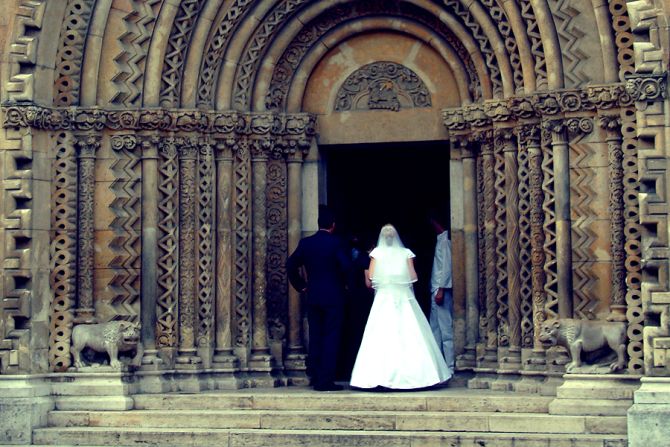CNA Staff, Mar 8, 2024 / 17:05 pm
As interfaith marriages can carry unique theological and pastoral challenges, Orthodox and Catholic Church representatives released earlier this week the latest guidance on these Catholic-Orthodox marriages in more than 30 years.
“The Pastoral Care of Mixed Marriages: Neither Yours nor Mine — but Ours” is a self-proclaimed “dialogue statement” between Catholic and Orthodox representatives that has “no authority” on either Church but instead offers recommendations to theologians and Church leaders.
Most notably, the document recommends that the Orthodox Church recognize Catholic marriage and the Catholic Church take steps to recognize Orthodox remarriages.
Dialogue, not declaration
The North American Orthodox-Catholic Theological Consultation, which wrote the recommendations, was “sanctioned by the hierarchies of the two churches to examine divisive issues and to make recommendations regarding ways to overcome them,” according to their website.
“Our Churches are working to overcome and heal the centuries-old separation,” the Consultation noted, adding: “We still stand before the Lord and sadly confess that our estrangement is not healed.”
The Consultation has released 31 statements since its founding in 1965 about Orthodox-Catholic relations that are strictly dialogue, not authoritative teaching.
“Like most dialogue agreed statements, this new text does not speak officially for either Church,” The USCCB noted in a statement on the document on Tuesday. “However, it has been drafted by a group of experienced theologians highly esteemed by their peers and submitted to all the members of both Churches for their prayerful reflection and discussion.”
Cardinal Joseph Tobin, the archbishop of Newark, New Jersey, and Metropolitan Methodios, the metropolitan of Boston, co-chaired the dialogue in Ontario, Canada, last spring.
The Consultation is sponsored jointly by the Bishops’ Committee for Ecumenical Relations of the Assembly of Canonical Orthodox Bishops of the United States of America, the Committee for Interreligious Affairs of the U.S. Conference of Catholic Bishops, and the Canadian Conference of Catholic Bishops.
Recognizing marriage would be a step toward ‘reunification’
On July 16, 1054, the Great Schism separated the Orthodox Church from the Catholic Church. The effects of this still resonate today, and interfaith couples face the challenge of differing theologies of marriage.
The Consultation document makes a number of recommendations regarding marriages between Orthodox and Catholic parties, the most revolutionary of which asks the Orthodox Church to recognize interfaith marriages performed in Catholic churches.
Because the Orthodox Church recognizes the priestly blessing as what establishes “the mystery of Orthodox marriage,” any valid Orthodox marriage needs an Orthodox priest or bishop present.
But in the Catholic faith, the couple confers the sacrament, not the priest. In “extraordinary circumstances, the man and woman can marry without the blessing of a priest,” the Consultation noted. Because of this, a Catholic-Orthodox couple would usually be married by an Orthodox bishop or priest, in an Orthodox Church.
However, the document suggests that the Orthodox Church recognizes these interfaith marriages in a Catholic Church.
(Story continues below)
Father Walter Kedjierski, who heads the Secretariat for Ecumenical and Interreligious Affairs for the USCCB, notes that this is a “humble recommendation.”
“Yet from the perspective of our Churches coming closer together, for the Orthodox to recognize Catholic marriage would be a major, major step toward our reunification, which is our ultimate goal,” he said.
The Consultation asks the Catholic Church to recognize Orthodox dissolution of marriages, and by extension, select remarriages between interfaith couples.
The Orthodox understanding of marriage is “lifelong,” but Church leaders can grant “exceptions” out of “pastoral recognition” of human “frailty and error,” the document noted.
The Catholic Church, meanwhile, allows annulments in cases where it can be determined that the initial requirements for the sacrament of marriage were invalid, rendering the marriage void in the eyes of the Catholic Church.
If the Catholic Church were to recognize an Orthodox dissolution of marriage, this would allow the Catholic party of a remarried interfaith couple to receive the Eucharist in the Catholic Church.
Mutually pastoral
Despite theological differences, the representatives of the two Churches recognize the importance of “shepherd[ing] the flock” in light of the cultural changes “in the wider world regarding marriage.”
“Many increasingly view the institution of marriage as superfluous and unnecessary, whether it is sanctioned by the state or by religion,” the Consultation noted. “Where matrimony does occur, civil marriage is becoming normative for many people.”
“We propose that instead of dividing the parties in a mixed marriage into yours and mine, to adopt, as a starting principle, a joint solicitude for the spouses and embark on the pastoral care of each mixed marriage as our concern,” the Consultation continued.
Determining which Church to raise children in can be another challenge of an interfaith marriage, but the Consultation emphasized that mixed marriage families are “our common concern.”
“Ideally, both Churches are jointly responsible for the pastoral care of spouses and children in mixed marriages,” the Consultation stated.
For the future
Kedjierski noted that the “practical effects of this document … have yet to be seen.”
“It all depends upon how well it is received by the bishops from our respective Churches, influential theologians (particularly in this case scholars in canon law) from both Church traditions and the lay faithful in the pews,” he continued.
Scholars will continue to engage the document and give commentary on it, the USCCB noted.
“The process of ecumenical reception takes time,” Kedjierski said. “This document is a point in an over five-decade-long discussion between Catholic and Orthodox Christians.”






